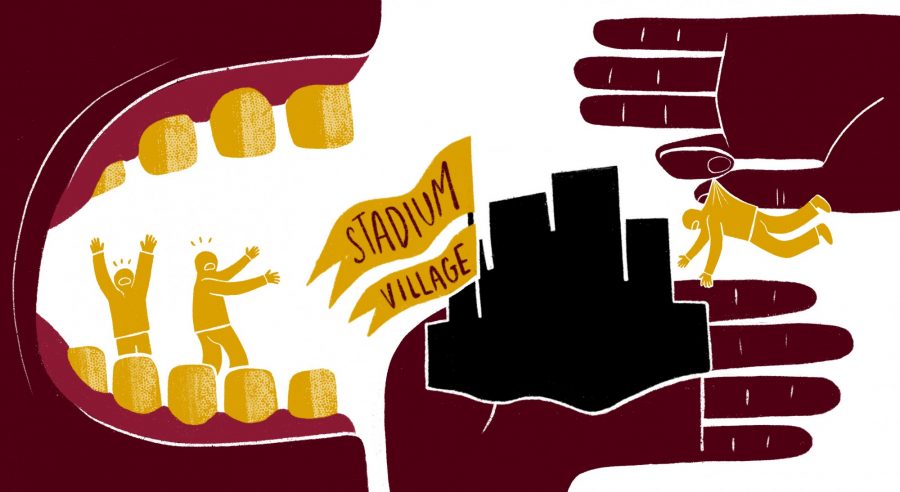The COVID-19 pandemic has not stopped the University of Minnesota’s continued land purchases in Stadium Village.
Over recent months, the University has pursued the acquisition of high-profile properties on the eastern edge of campus. The University’s recently approved budget is accounting for revenue losses, while state funding is uncertain amid the pandemic. As a result, some are left questioning the University’s bandwidth to continue purchasing property — totaling more than $30 million in just a few months.
But University leaders say the school needs to jump at the chance to own land when available in the highly demanded area.
“The University does not take these real estate transactions lightly,” said Leslie Krueger, the University’s assistant vice president for planning, space and real estate. “Similarly, in the context of the financial implications of COVID-19, we also normally balance the long-term planning with the short-term challenges that we’re facing.”
So far in 2020, the University has sought to buy multiple properties, including the Stadium Village Church and Classic City Apartments. These parcels will be used for the expansion of the clinical campus north of Fulton Street Southeast. The University will issue debt to acquire both of these properties, which is a typical practice.
But other plans, including possibly looking south of Fulton Street Southeast and future redevelopments in Stadium Village, will also be sought in the near future.
Property acquisitions in a pandemic
The University has recently taken some unprecedented approaches to balance its budget. Salary cuts and furloughs have amounted to about $50 million in savings and the school is relying more heavily on student tuition.
State funds are also in the air as the Legislature has been unable to take up a bonding bill, which includes the University’s funding request to help design the clinical facility.
“It’s a little weird for me to see property purchases when they’re also having a conversation about how the budget is so strained,” Minnesota Student Association vice president Becca Cowin told the Minnesota Daily in July while discussing the Stadium Village Church property acquisition.
Krueger said the University needs to balance its long-term strategic plan alongside these new financial constraints. Brokers regularly offer properties in the area to the University, but Krueger said administrators have intentionally selected the few to seek to purchase.
“We’ve been very judicious about what we brought forward to the board for recommendations,” Krueger said.
And some of that includes buying the property before others in the private sector do — especially after the city of Minneapolis’ 2040 Comprehensive Plan changed the zoning for the area around Classic City Apartments to allow buildings up to 30 stories.
This increased the value of the property, meaning that if the University did not act, Krueger said they likely would not be able to buy it in the future.
The University, as a long-term owner of property in the area, must be buying “in good times and in bad times,” said regent Richard Beeson.
“Land is a valuable commodity,” he said.
The $22-million sale of the Murphy Warehouse, located in Southeast Como, and $13.1 million sale of 435 acres of UMore Park property within the last few months will help offset the costs of the acquisitions, Krueger said.
Changes to land strategy over the years: south of Fulton
The 30-year campus plan, which was completed in 2009, outlines the blueprint for developing land in and around the University. At the time, no plans were made for acquiring property south of Fulton Street Southeast.
Years ago, the University told neighbors in Prospect Park, the neighborhood encompassing Stadium Village, that they would not be looking at properties beyond Fulton, said former Prospect Park Association president Vince Netz.
Netz said the University knew neighbors were worried about certain types of development — like blocks of academic buildings — altering its single-family home character, especially after the campus has consistently expanded closer to the core residential part of the neighborhood.
“When the University makes new plans, it would be useful … and helpful for it to at least listen to people who live here about how to make their buildings better,” Netz said. “We did have several retired architects on our board.”
Earlier this year, the University demolished recently acquired single-family homes on Erie Street Southeast, which are also south of Fulton, to help relocate properties that would be displaced by the clinical facility.
The University’s development plan, which was created in 2016 and includes parts south of Fulton, suggests acquisition of land whenever the opportunity arises.
Krueger said in the upcoming year, the University will be looking at the western side of Erie Street and working with University stakeholders and broader community members to update the master plan.
Administrators are also looking further ahead. Future plans include redevelopment of University Village, a University-owned student housing complex, and the neighboring Days Inn hotel property, where the University has a has 49% stake in ownership. Plans for the Days Inn property may be announced by the end of this year or in early 2021, Krueger said. It may be decades before there are plans for redeveloping University Village.
The University of Minnesota Foundation, a private nonprofit separate from the University, is also seeking to redevelop Stadium Village as part of the East Gateway project, with preliminary plans approved earlier this year. The plans include 3-million square feet of mixed-use development with small-business incubators and office, residential and green space.
To regent Beeson, the University acquiring property close to campus allows a mix of uses — not just what many developers have been creating: lots of student housing.
It is important to “think beyond formal borders and beyond strict academic needs,” Beeson said.
Abbey Machtig contributed to this story.
Clarification: The University is still in the process of buying the two properties mentioned. Debt will be issued at the time of purchase.








